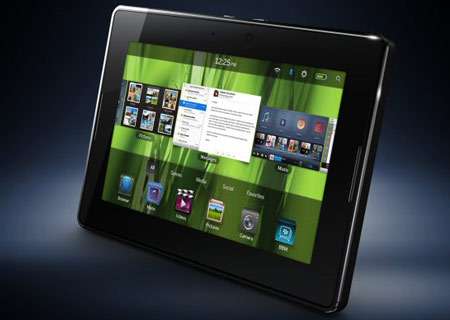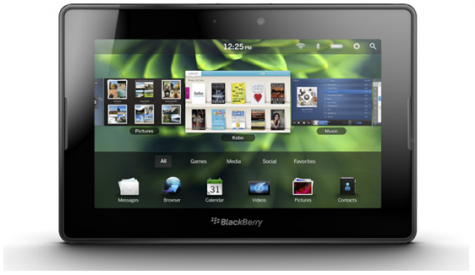Review: BlackBerry enters tablet market with PlayBook

BlackBerry, with its diminishing legions of devoted fans, is stepping delicately into the tablet market.
The stakes are high for Research in Motion, the maker of the BlackBerry, which has seen its market-leading mobile-phone presence overtaken by the Android and Apple platforms.
Unfortunately for BlackBerry, we live in iPad's world - a world where a successful tablet computer is crucial to the health of an overall mobile software platform.
Enter the BlackBerry PlayBook: a beautifully compact and vibrant tablet computer that runs on RIM's entirely new tablet operating system.
The PlayBook is available now and comes in 16-, 32- and 64GB versions priced at $499, $599 and $699 - the same price points as the WiFi iPads.
There are some crucial programs missing from the PlayBook at launch, though.
There are no apps to browse e-mail, calendar or contacts (yes, you read that correctly).
For each of those features, the PlayBook pulls wirelessly from a user's BlackBerry smartphone through a syncing program called Bridge.
All of that protected data stays on the BlackBerry as the PlayBook functions as a larger window into the phone's e-mail and other programs. For BlackBerry users, it's a slick solution that offers all the traditional heightened security settings of the RIM platform. Once the phone is disconnected from the tablet, all those apps go dark and the tablet is left without access to e-mail.
For users without a BlackBerry smartphone, the omission of a basic e-mail app is a monster-sized deterrent. RIM says that feature will come this summer through a software upgrade.
The PlayBook can connect to the Internet using WiFi, but also through a BlackBerry smartphone's existing wireless data connection. This means you don't need a separate contract with a separate carrier to browse the Web over a 3G network.
HOW DO I TURN THIS ON?
The PlayBook is much smaller than its chief competitors - the dominant Apple iPad and Android-based tablets like the Motorola Xoom and G-Slate from LG.
It's a great size, though, that opens up a whole new level of portability. RIM's tablet weighs less than a pound and has a great 7-inch widescreen LCD display that makes it a handy personal video player.
It has a super comfortable hardened rubber back interrupted only by the tablet's 5-megapixel rear-facing camera. The PlayBook also has a 3-megapixel front-facing camera, but lacks a program for video chatting. Expect that sometime this year.
The quality of the cameras is OK. Both perform somewhat poorly in low light.
The biggest weakness in the PlayBook's hardware, inexplicably, is the power button.
It is head-scratchingly difficult to turn on the PlayBook using its tiny, depressed power button. But once the tablet is turned on, a simple swipe on the touchscreen will wake it back up for each use.

NEW NAVIGATION A BREEZE
While the PlayBook's software options are limited at launch, the overall user interface is one of the best I've seen on a tablet.
The PlayBook has smartly worked its touchscreen navigation into the black frame that surrounds the display. A simple swipe down from the top reveals a menu of app-specific options. A swipe to the left or right from the opposite side switches from app to app, each frozen in the last-known state.
This new form of tablet navigation is instantly intuitive.
The PlayBook's Web browser is also one of the best on a tablet I've tested and includes full support for Adobe Flash video, something the iPad can't do.
The PlayBook launches with just 3,000 apps built for its tablet software. Apps built for BlackBerry smartphones won't work on the tablet's larger screen, but RIM says it's working to allow this.
The Apple iPad can boast more than 65,000 apps built for its larger screen.
BLACKBERRY BONA FIDES
Overall, the PlayBook is a strangely limited experience when pitted directly against the other powerful tablets on the market. Without basics like e-mail, it can't be pitched to customers as a standalone computing device.
If you don't own a BlackBerry smartphone, I can't recommend this tablet. For the same price, the iPad can do so much more.
It's easy to call the PlayBook half-baked.
But if you're a BlackBerry devotee tied to the platform's security settings and nuances, there is certainly some charm in seeing your phone's data on a beautiful widescreen display.
For the brave and oft-misunderstood army of BlackBerry users, the PlayBook might just be what they're looking for.
If they're up for paying $500 for charm.
BLACKBERRY PLAYBOOK
- Software: BlackBerry Tablet OS
- Size: 7.6-inches-by-5.1-inches-by-0.4-inches
- Weight: 0.9 pounds
- Screen: 7-inch LCD display; 1024x600 resolution
- Hardware: 1GHz dual-core processor with 1GB RAM, accelerometer, gyroscope, digital compass and GPS
- Cameras: 5-megapixel rear-facing, 3-megapixel front-facing; both shoot video
- Ports: Micro USB, Micro HDMI, headphone jack and a proprietary charging port
(c) 2011, Detroit Free Press.
Distributed by McClatchy-Tribune Information Services.





















